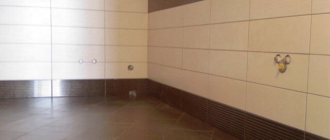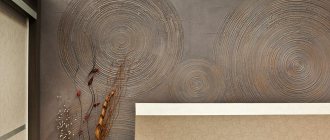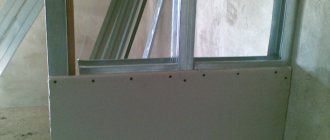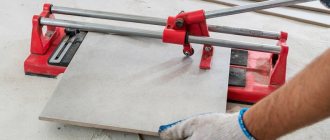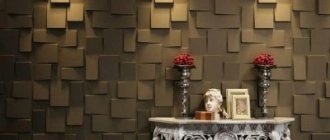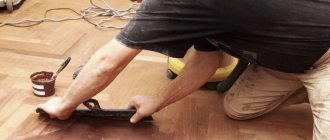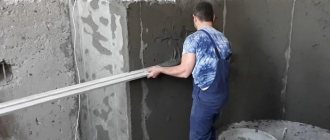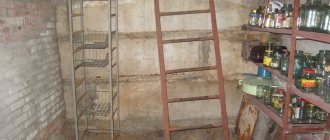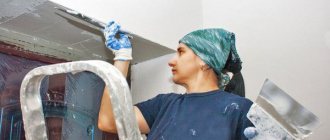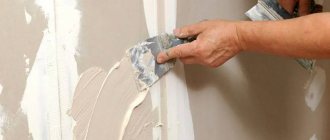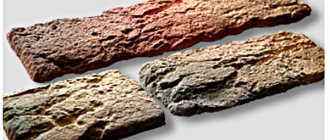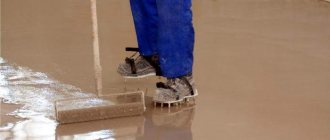Features of PVC and MDP panels
How do volumetric panels differ from other materials:
- strength and stability - the material is not exposed to the external environment;
- replacement of parts - in case of mechanical damage, the panel is replaced without disturbing the overall structure;
- sound insulation – PVC and MDF absorb noise;
- camouflage - panels are used to hide pipes, wires, and imperfections on the walls.
Attention! PVC and MDP panels do not require preliminary wall preparation.
To lay them, it is not necessary to make the surface perfectly flat. More sophisticated versions of such panels are models with foam plastic and mineral wool. They are used for cladding cold balconies for insulation purposes.
Decorative bricks in the interior of an apartment
When it comes to finishing, questions always arise related to what material to choose. The most popular solution is wallpapering or painting. Another fairly simple option is to create a brick wall from putty. This option has a lot of advantages, is inexpensive, and can be used in almost any room.
More details about decorative putty in the video:
On the balcony
Using plaster decor on the balcony is a good solution. With its help, you will be able to finish the walls in a short time, giving them a spectacular look. The bricks are painted. It is allowed to leave the decor in the original color. This solution is especially suitable if the ultimate goal is to create a loft style.
Living room
In the living room it is allowed to decorate all 4 walls with white brick. A fairly popular solution is to allocate a separate area (for example, an area in which a TV or sofa is located). For decoration, you will need to carry out preparatory work first. Putty is applied only to a leveled base.
Kitchen
In the kitchen, it is recommended to arrange an apron in this way. There are many different options for decorating the kitchen area. Choosing imitation putty allows you to get an attractive design object without spending a lot of time and money.
Bedroom
To transform the interior of the bedroom, you can use different materials. Brick decor goes well with both wallpaper and paint. You can select an area above the bed. Elements created from putty are painted in a color that matches the design.
Bathroom
The use of imitation brick in a bathtub is acceptable, but you will need to use a special putty that is resistant to high humidity. The end result will look cohesive and attractive. This option looks especially good in a room with a large area. Traditionally, the color of bricks is white. If desired, you are allowed to combine decor with tiles.
Expanded polystyrene
To create such bricks, ordinary foam is used. Some are content with the remains of ceiling tiles (but the elements from them turn out to be too thin), while others purchase sandwich panels and cut them into tiles about 1 cm thick. Polystyrene foam can be easily processed with an ordinary construction knife: with its help you can create the desired texture, and add fine relief with a wire brush.
This lightweight material easily sticks to walls, but does not have high strength, so it is not recommended for rooms with high operating loads. You should also take into account the painstaking nature of the work - preparing the elements requires time and patience.
Advantages of imitation putty
Among the main advantages of using putty to imitate brickwork are:
- availability;
- low time and material costs;
- attractiveness;
- durability;
- environmental friendliness.
A minimum set of tools is required for work.
To create an imitation using putty, you do not need many tools. After studying the technology, you are allowed to move on to work. Many successfully cope with finishing, even if they have not previously had experience in such work.
Important! To obtain a high-quality result, it is necessary to use certified building materials. Putty with the required characteristics can be purchased at any hardware store.
Style and design
Due to the fact that plastic material is used during finishing work, the builder himself has the right to give it shape. You can finish it in the form of classic brickwork, or experiment with:
- texture. Apply abrasions, stripes, designs to some bricks;
- colors;
- shape;
- the size of a brick.
Since you can use basic plaster, which is easily deformable and various manipulations.
Difficulties during the work process
Among the most difficult stages of work are:
- preparing the base for coating;
- drawing the boundaries of the seams of the future imitation;
- painting bricks.
Preparation can take quite a lot of time.
It is worth noting that if the base is level, the procedure will take place without any difficulties. Deep leveling of surfaces is required only for pronounced defects that are visible to the naked eye. Small irregularities and cracks do not need to be repaired, as they will be disguised by decorative elements.
The work can be done alone. The help of professional builders is necessary if the wall is in poor condition. To gain the necessary skills, it is recommended to practice, for example, on the balcony.
Expert advice
In order to imitate a brick wall as accurately as possible, you must adhere to the following tips:
- to create a believable imitation, it is necessary to respect the dimensions of natural bricks (250x120x65 mm) ;
- when caring for wallpaper or gypsum tiles, they should be wiped with a sponge or dusting brush, and decorative panels can be washed with soapy water, after which they are wiped dry;
- to get a nasty structure, use finishing plaster; such a wall will be a good background for creating various design styles;
- the color of the finish can be either traditional or other shades;
- if the walls of the room are decorated with brick, then it should have good lighting;
- You shouldn’t get too carried away with this type of decoration, if you have a low ceiling, it’s enough to make one wall or decorate part of it, otherwise the apartment will turn into a basement.
What you need to create a simulation
Among the materials that will need to be purchased for successful decoration are:
- primer;
- masking tape;
- paint;
- plaster;
- putty;
- varnish
In addition to materials, you need to buy tools. Among the devices that will definitely be needed during repairs are:
- putty knife;
- paint roller;
- tape measure and pencil;
- bucket for mixing the solution;
- paint container;
- stationery knife.
The method of simulating brick decor determines what materials and tools will be needed. If additional devices are required during the repair, they can always be purchased. It is recommended to first provide yourself with the essentials.
What does it look like
Painting a wall to look like brick is perhaps the cheapest way to imitate it. Plus it's practical. While wallpaper can get dirty or damaged by pets, this will not happen with painting. Unlike wallpaper, you don’t have to rip off the paint if you get tired of it—you can simply repaint the wall.
Painted brickwork, of course, does not look as impressive as the original, but it will also suit any design solution. A clear example of this is in the photo below.
Preparing the base
If the base is level, and in the future it is planned to apply a thin layer of putty, then the first step should be a thorough primer. Due to this, it is possible to increase the adhesion (cohesion) of the layers. This way the putty will adhere much better. Priming is carried out in several layers.
The primer is applied with a roller
To level a very crooked concrete wall, plaster will be required. Typically, alignment is performed using beacons. The plaster dries within a few days. After preparing the rough surface, priming and marking are performed.
Wallpaper
Yes, you read that right. Wallpaper has come a long way over the years, and brick print wallpaper is no exception. Easy to use and can be applied by a non-trained person, but now available in textured options. You will love the charm they add to your home. Find some great inspiration below.
Marking
The easiest way to mark is to use thin masking tape. You will first need to draw the masonry with a marker. Tape will be glued along the finished lines. If you don’t want to waste time gluing tape, then it is recommended to purchase ready-made brick wall templates for interior decoration. They are sold in many hardware stores. The template is also worth considering if you plan to decorate a large room.
After the markings have been applied, you can proceed to applying putty. It is worth remembering that the final result will depend on the accuracy of the markings.
Important! When using adhesive tape, you must leave the ends of the adhesive tape free so that it can be easily removed after drying.
Applying decorative putty
The product is applied in a small layer, but at the same time covering the previously applied markings.
When preparing the solution, mix thoroughly. Its consistency should not be too dry or liquid. The ideal solution is one that has a plastic shape, but does not flow down the wall.
Use smooth movements to spread the mixture over the entire surface.
Application is carried out with a spatula. The putty spreads evenly over the entire surface. It is important to wait for the material to dry completely. Only after this is it possible to delete the template or markup.
PVC panels
Designed for decorative finishing of hallways, kitchens, bathrooms or balconies. The polyvinyl chloride from which the panels are made is not afraid of water, and the minimum thickness of the product gives it elasticity. Some will consider this a disadvantage, while others will turn it into an advantage by creating semicircular or uneven surfaces and easily cutting the required amount of material with scissors.
For installation, glue or liquid nails are used. Some products already contain an adhesive layer. The main disadvantages of the panels are the repeatability of the pattern, as well as seams and artificiality of the material, visible to the eye.
Formation of individual bricks
While applying the mixture, you can do separate work with the bricks. If you want to give them a rough surface, then after spreading the putty you need to use a special texturing roller. You can also add roughness with a simple sponge.
If a high-quality stencil was used, then there will be no need to shape the bricks in any way. The masonry will form on its own when the template is peeled off. When using adhesive tape, certain disadvantages may arise. If somewhere you get a weak seam, you can refine it using a regular scraper.
Drywall
A method for lovers of smooth brickwork and handicrafts. In addition to gypsum board, you will need a stationery knife and a ruler, and putty to give the material texture.
First, a sheet of plasterboard is cut into even strips 65 mm wide, then cut on both sides and broken. Bricks are formed from the resulting strips.
If the cladding area is large, the process takes a long time. The finished elements are fixed with ordinary tile adhesive.
The surface can be left smooth or, by removing the top layer of cardboard, you can make notches and irregularities on it. You can imitate the texture and seams between tiles using putty or glue, and transfer the color with acrylic or water-dispersion paint.
A more detailed master class can be found in this video:
Finishing
Finishing involves removing visible imperfections to give the wall the most attractive appearance. Typically, the following actions are performed:
- sharp protrusions and sagging are eliminated;
- the seam becomes more pronounced;
- grind off the protruding points using sandpaper;
- painting is done.
To give the decor the desired color, you need to paint the bricks. It is better to paint the surface before removing the markings. If the marking has already been removed, you will need to protect the seam with masking tape.
Before painting, the imitation will need to be primed again. The paint can be applied with a roller. To obtain a monotonous color, most often only 2 layers are required. After the paint has dried, a varnish coating is applied, which protects against adverse external influences and fading.
For better coloring, you can use a brush
The seams can also be painted to give them a more attractive look. It is necessary to use tape if different colors are used.
We combine the incongruous
A brick wall is original, impressive and fashionable. But how can you choose the rest of the design as organically as possible?
Designers advise:
- Very often such a wall combines several shades. In this case, it is better to select furniture using the darkest and lightest colors as a basis.
- The rigor of the design can be enlivened by a bright carpet or eye-catching accents, such as colorful pillows on the sofa.
- Red brick color goes well with orange, yellow, and blue. This combination is especially effective in oriental ornaments.
How to paint brick trim
The paint must be chosen correctly. Among the available options that can be applied to putty are:
- acrylic paint;
- latex compounds;
- water-based paint.
The color is selected individually to suit the planned design of the room. The most popular shades are white, red-orange and brown. Almost all types of plaster can be finished well with paint, so the end result will be high-quality and effective.
Before painting, you need to clean the surface of debris and dirt.
If bricks are painted in several layers, then you need to wait about 5-7 hours before applying a new layer. The result will depend on the quality of the painting. Be sure to apply varnish at the end to protect and increase the life of the decor.
Flexible tiles
This material consists of 90% marble or quartz fraction and acrylic binders. The flexible base allows you to cover corners, and due to its moisture resistance, the “brick” can be used in rooms with high humidity – bathrooms and swimming pools. Also suitable for decorating facades. Available both as individual elements and in rolls. Installation requires an acrylic primer and adhesive specifically for flexible stone.
The advantage of the material is durability (25 years of service), the disadvantage is high price.
How long does it take to make bricks from plaster?
It will take about 3 days to finish an entire room with decorative plaster. In this case, most of the time will be spent waiting for the materials to dry. After applying the mixture according to the template, it is enough to wait 8-12 hours. After this, you can proceed to the final stages of finishing.
Using decorative masonry indoors is a popular and easy way to give your interior an attractive look. It is permissible to use putty in both insulated and cold rooms, for example, on a balcony or loggia. External finishing of private houses can be done using similar technology.
It will be difficult to make an imitation yourself if you approach this procedure responsibly. The work should be divided into several stages. Be sure to start by preparing a plan. After this, the required amount of building materials is purchased. Finishing should only be applied to the prepared coating. If the basic rules are followed during repairs, the finished decorative surface will last at least 5 years.
Learn more about finishing the inside of an apartment using putty in the video:
Ready-made gypsum tiles
This is one of the simplest and most successful ways to decorate a wall: the tiles are sold in boxes, their quantity is easy to calculate.
It weighs little and requires minimal effort when facing. It comes in a variety of colors and can imitate aged masonry. Gypsum “bricks” are attached with special glue. Carry out the cladding as carefully as possible so that the adhesive is not visible in the seams. The finished wall can be painted to even out the color, or varnished.
Another advantage of facing tiles is its environmental friendliness, since gypsum is a natural material. The wall will last for several years and will provide additional sound insulation.
